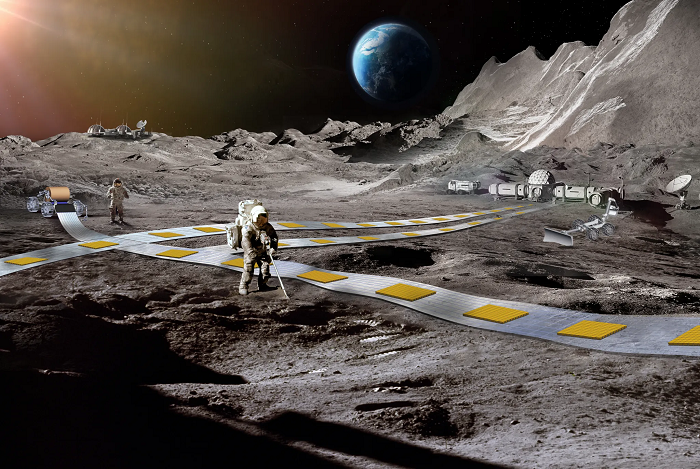ISABEL RUBIO ARROYO | Tungsteno
NASA has announced an ambitious initiative to build a revolutionary railway system on the Moon. It may sound like science fiction, but this innovative concept involves laying flexible tracks directly onto the lunar surface and using magnetic robots that levitate above the tracks to transport cargo.
The system, called Flexible Levitation on a Track (FLOAT), is designed to minimise wear and tear from abrasive lunar dust, and each levitating robot will be able to carry payloads of over 30 kilograms. The FLOAT project has already moved beyond the initial development phase. We look at the potential and challenges of this project, which NASA believes will play a critical role in supporting the establishment of a permanent lunar base by the 2030s.
Robots that levitate over a flexible track
"We want to build the first lunar railway system, which will provide reliable, autonomous and efficient payload transport on the Moon," says Ethan Schaler, a robotics engineer at NASA's Jet Propulsion Laboratory. The FLOAT project aims to develop "a durable, long-life robotic transport system” that will be “critical to the daily operations of a sustainable lunar base in the 2030s".
According to NASA, the FLOAT system would use magnetic robots that levitate over a flexible film track composed of three layers: a graphite layer that allows the robots to magnetically float over the tracks; a second layer of flexible circuitry that generates electromagnetic thrust to controllably propel the robots; and a third layer with solar panels that would generate electricity when exposed to sunlight. Unlike traditional lunar rovers with wheels, legs or tracks, "FLOAT robots have no moving parts and levitate over the track to minimise lunar dust abrasion and wear".
NASA is working to develop a robotic transport system to help astronauts on the Moon. Credit: Mirror Now
From transporting materials to exploring the Moon
The Moon is the Earth's only natural satellite. With a diameter of 3,475 kilometres, it is also the fifth largest satellite in the Solar System. There are plans to exploit resources such as regolith (lunar dust) or other minerals. A lunar railway system could transport these materials efficiently, reducing the need for multiple costly and complex missions using smaller vehicles.
NASA's goal is for each robot to be able to carry payloads of various shapes and sizes at speeds of more than 0.5 metres per second. When fully implemented, it is estimated that the system could move up to 100,000 kilograms of regolith or payload over several kilometres each day. Such a train would also allow equipment and samples to be transported safely and efficiently between research stations and to explore remote, hard-to-reach areas.
James B. Irwin, junto al vehículo lunar durante la primera actividad extravehicular del Apolo 15. Crédito: NASA.
The challenges of implementing the lunar train
The FLOAT project has entered its second phase, which will see up to $600,000 invested in a two-year study to investigate key technical and budgetary hurdles. During this phase, NASA will design, build and test small prototypes in conditions similar to those found on the Moon. It will also study the impact of factors such as temperature, radiation and lunar dust on system performance. In addition, a roadmap will be developed to optimise the manufacture of critical components such as magnetic arrays and flexible circuits.
Although the FLOAT system has the potential to transform lunar transport, it faces technical challenges. These include extreme conditions, regolith abrasion, power supply and high development costs. In addition, such a system has never been tested anywhere other than on Earth. Although prototypes can be tested under similar conditions on our planet, only an actual deployment on the lunar surface would provide the necessary data to safely validate the technology.
The FLOAT project could revolutionise lunar exploration. Credit: NASA
This project still faces numerous challenges, and NASA has not set a specific implementation date. Currently, NASA's Artemis III mission is expected to return astronauts to the lunar surface by 2026 at the earliest, marking the first manned lunar landing since the historic Apollo 17 mission in 1972. FLOAT is just one of six innovative proposals that have received funding in the second phase of NASA's Innovative Advanced Concepts (NIAC) program. Other projects include powerful telescopes, a propulsion system designed to transport cargo and people to Mars, and new power sources for future space missions.
Tungsteno es un laboratorio periodístico que explora la esencia de la innovación.
